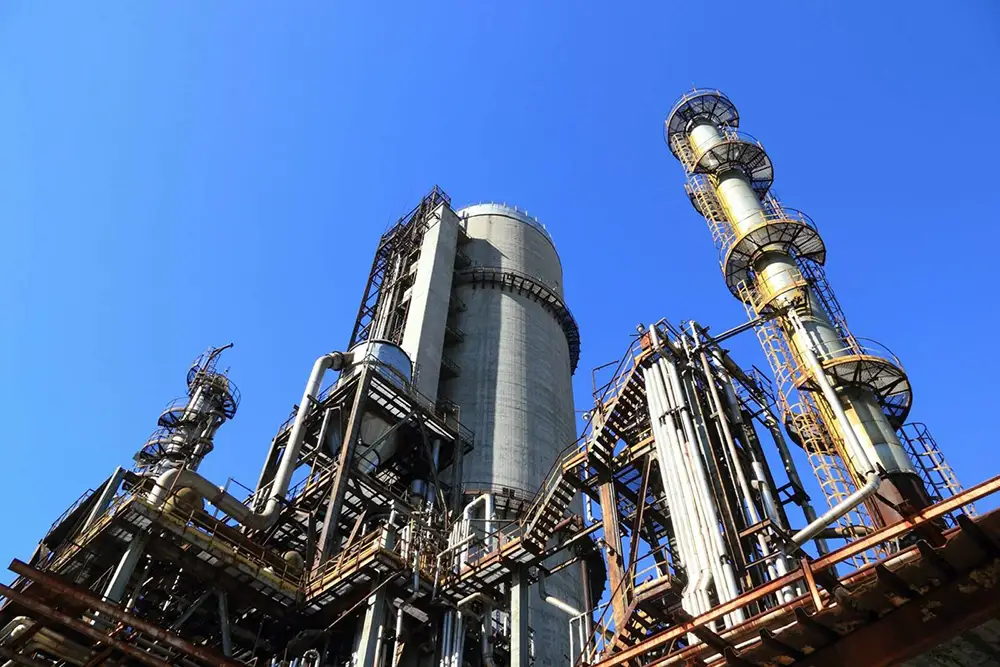지구의 땅은 유한한 자원입니다. 역사적으로 우리의 행동과 관행이 미래 세대에게 어떤 모습으로 땅을 물려줄지에 대한 고려는 거의 없었습니다. 하지만 지금까지는 말입니다. 전 세계적으로 제품 수요가 증가함에 따라 제조업은 당분간 성장세를 멈추지 않고 있지만, 여전히 세계 최대의 오염 배출원 중 하나입니다. 또한 긍정적인 변화를 주도하고 지구를 보호하는 데 중요한 역할을 합니다. 리더들은 기업의 환경 발자국을 줄이기 위해 토지를 어떻게 활용할지 등 이러한 변화를 주도할 수 있습니다.
제조업체에 대한 압력은 사라지지 않고 오히려 심화되고 있습니다. 유럽 연합(EU)을 포함한 전 세계 각국 정부는 다음과 같은 엄격한 조치를 도입하고 있습니다. EU 산림 벌채 금지 규정(EUDR) 삼림 벌채와 관련된 제품을 금지하는 EUDR과 유사하게, 미국은 해외 법치주의 및 환경적으로 건전한 무역 육성법(FOREST Act)을 제안했습니다. 이 법은 "불법적으로 벌채된 토지에서 생산된 특정 상품의 시장 진입을 제한"합니다. 호주에서는 2019년 산업 화학물질법(Industrial Chemicals Act 2019)이 산업용 화학물질의 도입 및 사용을 규제하여 제조업체가 안전 및 환경 기준을 준수하도록 보장합니다.
여러 지역에서 규제의 수와 범위가 확대됨에 따라 토지 이용과 관련된 재정적 위험이 커지기 시작했습니다. 규제는 계속해서 발전하여 더욱 강력하고 포괄적이 될 것이며, 이는 리더들의 단호한 행동의 필요성을 더욱 강조합니다. 제조업체는 이러한 변화하는 규제나 법률을 피할 수 없으며, 이러한 과제에 정면으로 맞서야 합니다.
좋은 소식은 지속 가능한 토지 이용 정책과 소규모 공장과 같은 솔루션을 채택함으로써 제조업체가 과거의 흐름을 바꾸고 긍정적인 영향을 미칠 수 있다는 것입니다.
현황: 제조업의 토지 이용 현황
토지 이용을 최적화하는 리더들은 환경 발자국을 줄이고, 자원 효율성을 높이며, 고객에게 환경에 대한 진정한 관심을 보여주는 등 상당한 이점을 누릴 수 있습니다. 토지를 더욱 효과적으로 활용함으로써 제조업체는 다양한 규정을 준수하고, 규정을 준수하며, 위험을 관리하여 지속가능성이 점점 더 중요해지는 시장에서 장기적인 성공을 보장할 수 있습니다.
스미소니언 보고서에 따르면, 인류는 지구 끝까지 확장하여 모든 대륙에 거주하며 지구 육지 면적의 최소 83%에 영향을 미치고 있습니다. 제조업체는 책임감 있는 토지 이용을 보장하는 동시에, 사업 운영이 토지를 포함한 환경에 미치는 장기적인 부정적 영향을 줄이기 위해 미래 지향적이어야 합니다.
세계경제포럼(WEF)은 "광범위한 토지 사용과 전환이 우리 지구의 건강을 위협하고 있다"고 밝혔으며, 지구 표면의 4분의 3이 이미 상당히 변형되었다고 밝혔습니다.
지속가능한 관행에 대한 초기 투자가 상당할 수 있지만, 전반적으로 책임감 있는 토지 이용에는 폐기물 감소를 통한 장기적 비용 효율성 등 긍정적인 측면이 있습니다. 세계경제포럼(WEF)은 또한 기업들이 토지, 식량, 해양 이용 시스템의 지속가능한 전환을 지금 당장 받아들인다면 거의연간 가치 $3조 6천억 2030년까지 1억 9,100만 개의 일자리를 창출할 것입니다. 그러나 이러한 가치를 포착하려면 제조업체는 사업 계획을 검토하고 환경, 사회, 거버넌스(ESG) 목표에 따라 토지 사용을 해결해야 합니다.
토지를 보존하고 활용을 최적화하기 위한 5가지 주요 전략:
CEO들이 전례 없는 변화에 맞서 싸우는 동안, 이러한 실용적인 전략을 사업 운영에 반영함으로써 토지에 미치는 영향을 줄이고 스마트 제조와 친환경 기술과 같은 혁신적인 솔루션을 통해 디지털 혁신을 추진할 수 있습니다. 제조업체를 위한 책임 있는 토지 관리를 위한 다섯 가지 미래 지향적 접근 방식은 다음과 같습니다.
1. 지속 가능한 소싱
제조업체에는 원자재가 필요하지만, 토지에서 지속 가능한 조달과 책임감 있는 토지 관리를 통해 이러한 원자재를 추출하고 가공하는 데 따르는 탄소 배출량을 줄일 수 있습니다.
2. 토지 이용 계획
토지 이용 계획과 제조를 결합하면 환경에 미치는 영향을 줄이는 데 도움이 될 수 있습니다. 예를 들어, 공유 자원을 활용하는 공장을 설계하고, 재생 에너지를 사용하고, 효과적인 폐기물을 관리하면 탄소 배출량을 줄일 수 있습니다.
3. 탄소 포집
건강한 생태계는 탄소를 격리할 수 있습니다. 또한, 국제자연보전연맹(IUCN)은 토양 보호 및 복원이 2030년까지 지구 온난화를 1.5°C 이하로 유지하기 위해 필요한 가장 비용 효율적인 완화 조치의 33% 이상을 차지한다고 지적합니다.
4. 마이크로공장
소비자와 공급자에게 더 가까이 접근하여 운영함으로써, 마이크로공장 장거리 운송 요건을 줄일 뿐만 아니라 기존 시설보다 본질적으로 지속가능성이 높으며, 설치 면적이 작아 토지 사용량도 줄어듭니다. 이러한 소형 첨단 공장은 제조업의 미래를 바꿀 잠재력을 가지고 있습니다.
5. 위치 선택
CEO는 환경 영향을 최소화하는 제조 시설을 전략적으로 선택해야 합니다. 토양이 깨끗하고 공급업체 및 시장과 가까운 곳을 선택함으로써 운송 과정에서 발생하는 배출가스를 줄이고 오염 물질 유입 위험을 줄일 수 있을 뿐만 아니라, 더욱 지속 가능하고 효율적인 운영을 구축할 수 있습니다.
지속 가능한 토지 이용의 실제 사례 연구 - 하이델베르그 머티리얼즈
독일 하이델베르크 머티리얼즈(Heidelberg Materials)는 사업 목적으로 사용되는 토지의 임시 관리자로서의 책임을 인식하는 건축 자재 기업입니다. 책임 있는 관리자로서, 하이델베르크 머티리얼즈의 책임 있는 토지 이용 정책에는 책임 있는 토지 이용, 환경 영향 이해 및 보고, 기업 전략 통합, 생물다양성 관리, 토지 보상 및 상쇄 등 다양한 활동이 포함됩니다. 또한 모든 인권을 존중하고 이해관계자 참여를 촉진하기 위해 노력하며, 이러한 노력은 브랜드 평판을 향상시켜 수익 증대로 이어질 수 있습니다.
토지 소비자에서 환경 보호론자까지 – 이 부문이 토지 남용을 어떻게 바꿀 수 있는가
요약하자면, 제조업 분야의 혁신은 심각합니다. 자동화, AI 통합, 지속가능한 활동과 같은 혁신과 더불어 엄격한 배출 지침 및 폐기물 관리 전략과 같은 규제 변화가 주도하고 있습니다. 이러한 산업의 과제는 제조업 리더들의 신속한 사고와 적응을 요구하며, 혁신이 필요하고 앞으로도 지속될 것이라는 사실을 받아들여야 합니다. 고통스럽지만, 제조업은 지속가능한 토지 이용 및 토양 보호 이니셔티브를 포함한 ESG 친화적인 이니셔티브 도입을 위한 길을 마련해야 합니다. 이러한 변화는 ESG 개선을 촉진할 뿐만 아니라 규제 준수 및 시장 경쟁력 강화와 관련된 위험을 줄여 궁극적으로 기업을 보호할 수 있습니다.
우리의 실용적인 소비자 지속가능성 산업 준비 지수 평가, 우리는 비효율성을 발견하여 새롭고 지속 가능한 미래를 계획할 수 있습니다. 맞춤형 COSIRI 로드맵에는 구체적인 이정표, 단계별 조치, 필요한 자원, 그리고 목표가 포함됩니다. 보이지 않는 것은 알 수 없으며, COSIRI는 귀사가 가장 부정적인 영향을 미치는 부분을 파악하여 위험 완화를 위한 훌륭한 출발점을 제공합니다. 더 자세한 내용은 당사에 문의하십시오. 인증된 COSIRI 평가자 오늘 ESG 여정에 활력을 불어넣으세요.
제조업의 책임 있는 토지 이용에 대한 자주 묻는 질문
제조업에서 책임 있는 토지 이용이란 무엇인가?
제조업에서 토지를 책임감 있게 이용하려면 환경 영향을 최소화하고, 지역 사회를 지원하며, 지속 가능성과 규제 목표에 부합하는 방식으로 산업용 토지를 계획, 개발, 관리하는 것이 필요합니다.
산업 개발에 있어서 책임 있는 토지 이용이 중요한 이유는 무엇인가?
책임감 있는 토지 이용은 천연자원을 보호하고, 오염을 줄이며, 환경법 준수를 보장하고, 제조업체의 장기적 부지 생존 가능성을 촉진하기 때문에 산업 개발에 중요합니다.
제조업에서 지속 가능한 토지 개발을 위한 모범 사례는 무엇인가?
모범 사례로는 환경 영향에 따른 부지 선정, 친환경 건축 자재 사용, 자연 생태계 보존, 에너지 효율적인 인프라 구현, 순환 경제 원칙을 토지 이용 계획에 통합하는 것 등이 있습니다.
제조업체는 시설 확장 시 토지에 미치는 영향을 최소화하려면 어떻게 해야 할까요?
제조업체는 기존 산업 부지를 재활용하고, 컴팩트하고 효율적인 레이아웃을 설계하고, 녹지 공간을 보존하고, 토양 교란을 줄이고, 친환경 건설 기술을 사용함으로써 토지 영향을 최소화할 수 있습니다.
책임 있는 토지 이용은 ESG 규정 준수를 어떻게 지원합니까?
책임감 있는 토지 이용은 환경적 피해를 줄이고(E), 지역 사회 복지에 기여하며(S), 토지 개발 결정을 투명하고 윤리적인 거버넌스 관행에 맞춰 조정함으로써(G) ESG 규정 준수를 지원합니다.
제조업에서 토지 이용 계획이 부족하면 어떤 환경적 위험이 초래될까요?
부실한 토지 이용 계획은 토양 오염, 수질 오염, 생물 다양성 손실, 그리고 탄소 배출량 증가로 이어질 수 있습니다. 이러한 위험은 생태계를 파괴하고 제조업체에 법적, 재정적 처벌을 초래할 수 있습니다.
제조업체는 토지 계획에 녹색 인프라를 어떻게 활용할 수 있을까?
제조업체는 우수 정원, 투수성 포장도로, 녹색 지붕, 자연 완충 지대, 에너지 효율적인 배수 시스템과 같은 녹색 인프라를 활용하여 환경에 미치는 영향을 줄이고 지속 가능한 토지 이용을 촉진할 수 있습니다.
책임 있는 토지 이용에 있어 규정 준수는 어떤 역할을 합니까?
규제 준수는 토지 개발이 환경법, 용도 지역 규정 및 지속가능성 기준을 준수하도록 보장합니다. 제조업체가 불이익을 받지 않도록 돕고, 더욱 안전하고 책임감 있는 토지 이용 관행을 확립하는 데 기여합니다.


